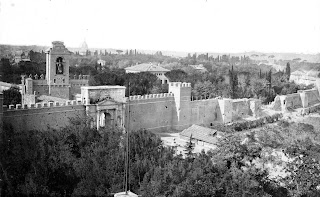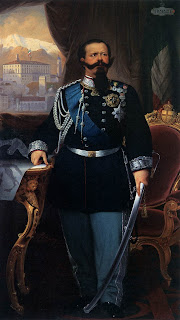First King of Italy calls himself Victor Emmanuel II
 |
| The inauguration of the first Italian parliament, as depicted by the Dutch artist Pierre van Elven |
The first Italian parliament to meet in the city confirmed Victor Emmanuel as the first King of the new country.
It was the monarch's own choice to call himself Victor Emmanuel II, rather than Victor Emmanuel I. This immediately provoked criticism from some factions, who took it as implying that Italy had always been ruled by the House of Savoy.
Victor Emmanuel I, with whom Victor Emmanuel II had ancestral links, had been King of Sardinia - ruled by the Dukes of Savoy - from 1802 until his death in 1824.
Victor Emmanuel II had become King of Sardinia in 1849 after his father, Charles Albert, abdicated. His father had succeeded a distant cousin, Charles Felix, to become King of Sardinia in 1831.
The Kingdom of Sardinia is considered to be the legal predecessor to the Kingdom of Italy.
As King of Sardinia, Victor Emmanuel II had appointed Count Camillo Benso of Cavour as Prime Minister of Sardinia-Piedmont, who had then masterminded a clever campaign to put him on the throne of a united Italy.
Victor Emmanuel II had become the symbol of the Risorgimento, the Italian unification movement in the 19th century. He had supported Garibaldi’s Expedition of the Thousand in 1860, which resulted in the fall of the Kingdom of the Two Sicilies, giving him control over the southern part of the country.
But when he ascended the throne there were still two major territories left outside the new Kingdom, Rome and the Veneto.
 |
| The Palazzo Carignano, the house in which Victor Emmanuel II was born and where the first Italian parliament met |
The first Italian parliament met in Palazzo Carignano in Turin, the house in which the first King of the new, united Italy, Victor Emmanuel II, was born. The baroque palace in Via Accademia delle Scienze which dates back to 1679, now houses a Museum of the Risorgimento. The painting of the inauguration shown above, by the Dutch artist Pierre van Elven, is on display there.
 |
| A remarkable early photograph shows the point at which the walls of Rome were breached, to the right of the Porta Pia gate |
Travel tip:
Rome remained under French control after the first Italian parliament proclaimed Victor Emmanuel II the King of Italy, despite attempts by nationalists to liberate it. But after the outbreak of the Franco-Prussian war, Napoleon III withdrew some of his troops. Italian soldiers seized their chance in 1870 and after a brief bombardment entered Rome through a breach in the walls at Porta Pia. Victor Emmanuel took up residence in the Quirinale Palace, the tricolore was hoisted and Italy was declared officially united. A marble plaque commemorating the liberation of Rome was placed near Porta Pia where the Italian troops first got through on 20 September.
Rome hotels by Booking.com
More reading:
Why Giuseppe Mazzini was the ideological inspiration behind the Risorgimento
The birth of the Italian constitution
The first King to be called Victor Emmanuel
Also on this day:
1826: The birth of inventor Innocenzo Manzetti
1925: The birth of acclaimed actor Gabriele Farzetti
1939: The birth of football coach Giovanni Trapattoni
Home








